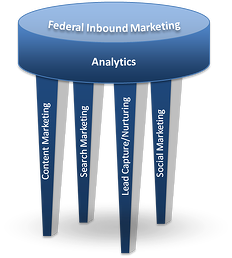Numerous federal marketing experts such as Mark Amtower have been encouraging government contractors to increase their use of social media for several years now, and for good reasons. Social media marketing helps you connect with agency users and buyers, establishes your firm as a thought leader, helps build brand, and generate leads.
Social media marketing is but one of the several tactics that have evolved in recent years due to changes in customer buying habits. Buyers now have far greater access to information than ever before, and therefore, the sales/procurement paradigm has shifted control of the process to the buyer. In the past, firms could bombard their market with direct mail, print and media advertising, email blasts, cold calls and other costly outbound marketing techniques, in order to find some customers. But today’s buyers have constructed many defenses against these traditional techniques, so they are no longer as effective as they once were.
To be clear, these traditional methods are not dead, they are just far costlier, far less effective, and deliver far fewer leads than newer marketing methods known as Inbound Marketing. And it doesn’t matter whether we are talking about business-to–consumer (B2C), business-to-business (B2B), or business-to-government (B2G); inbound marketing methods work! Three-quarters of federal agencies find and evaluate vendors by searching the web rather than using government sites like GSA Advantage, CCR and FedBizOpps. Most of these agencies are nearly done with their research before they even talk to you for the first time.
Federal Inbound Marketing
 So what is inbound marketing and how can it be applied in the federal market? Social media marketing is a smart tactic for the reasons stated above, but it is not the only marketing tactic that should be employed for achieving the best result. Inbound marketing is comprised of four components, all integrated for maximum effect, and thoroughly measured and analyzed. The four legs of inbound marketing are social media marketing, content marketing, search marketing, and lead capture and nurturing. Individually, all of these methods can deliver good results, but when properly integrated, the results grow exponentially. By implementing these four tactics together, your firm will be found by more interested buyers, convey your brand and value, capture more leads, deliver more opportunities, and help your business developers close more deals.
So what is inbound marketing and how can it be applied in the federal market? Social media marketing is a smart tactic for the reasons stated above, but it is not the only marketing tactic that should be employed for achieving the best result. Inbound marketing is comprised of four components, all integrated for maximum effect, and thoroughly measured and analyzed. The four legs of inbound marketing are social media marketing, content marketing, search marketing, and lead capture and nurturing. Individually, all of these methods can deliver good results, but when properly integrated, the results grow exponentially. By implementing these four tactics together, your firm will be found by more interested buyers, convey your brand and value, capture more leads, deliver more opportunities, and help your business developers close more deals.
Four Legs of Inbound Marketing
Social Media Marketing –social media marketing helps you interact with potential buyers, establishes your firm as a thought leader, build brand and a loyal following, and generate leads. Firms should connect with prospective customers at any number of social media sites, such as LinkedIn, GovLoop, Twitter, to name a few. By connecting, I mean joining and participating in various online groups, answering questions, providing valuable information, offering your thoughts and assessments on the issues of the day. It does not mean one way communications or broadcasting assertions about how great your firm is. Doing so can actually damage your reputation, so keep in mind that you will build credibility by two-way communication and meaningful participation.
Content Marketing –by creating notable content and posting on your web site and other platforms, search engines will begin ranking your site higher, more of your web pages will be ranked, and page views will go up. Great content gives you more opportunities to be found and create a favorable impression and trust with your customers. Examples of content that should be created include blog articles, white papers, e-books, webinars, how-to videos, among others. For the federal market, make sure you understand and write content that addresses their specific needs. While some issues your firm deals with are similar in both the B2B and B2G markets, federal agencies have a subset of issues that are unique from any other market.
Search Marketing – this leg includes search engine optimization (SEO) and in some cases, pay-per-click advertising (PPC). When publishing remarkable content, remember there are ways to do this that will maximize your getting found by the search engines and getting higher rankings for key words. There are both on-page SEO methods and off-page SEO methods, and employing both methods are important. PPC can also be used, but it can be expensive, so we prefer to use this sparingly in cases when competition for a particular term is great, and before other techniques are able to drive up your rankings.
Lead Capture and Nurturing – All the above methods are designed to get you found by your target market. However, attracting federal buyers is not enough. You must convert these visitors to leads in order to bring them into the top of your sales funnel. Employing the right Calls-to-Action (CTA) will allow visitors to obtain additional valuable information in exchange for their lead information.
It s important to provide CTA’s based on where visitors are in their buying cycle. For example, if you sell survey software for you might provide a CTA for downloading a white paper on the benefits of using automated surveys. For visitors who already know these benefits and are looking to buy a software program, you might provide a checklist of what features to look for in buying survey software.
Once these leads are captured, a lead nurturing program should be designed to help pull them through your sales funnel in a way that helps business developers close deals more quickly. Lead nurturing usually encompasses email marketing and newsletters that are designed to bring each buyer to the next level in their buying cycle.
The Importance of Analyzing Results
Those four legs of federal inbound marketing, if properly integrated, will yield a far greater number of opportunities for your firm. But how would you know what is working and what is not unless you had solid analytics to inform future decisions. Metrics will help determine what is working and what is deficient.
For example, proper analytics would tell you what keywords your site is being ranked on in the search engines. By knowing this, you can determine what additional content is needed to drive up rankings on lower ranked keywords. By knowing what type of content is attracting the types of customers you want, you can write similar articles that gain you even more targeted customers and discontinue writing content that does not deliver. Also, knowing which type of CTA is delivering results through A/B testing enables you to maximize lead conversion. By making adjustments based on data about what works, agencies will find you more often, you will convert more leads, and you will help your sales team close more deals.
Marketing to federal agencies has always been challenging, and perhaps even more so now that older tried and true outbound marketing methods no longer work as effectively. But social media marketing and other federal inbound marketing methods can deliver eve greater results more cost effectively when employed in a smart, integrated fashion.
To learn more about Federal Inbound Marketing and an assessment of your firm's program, register for our free federal inbound marketing assessment and private webinar.About the Author: Robert Kelly
Robert Kelly is the President and Principal Consultant at TurboGSA, a consultancy thathelp firms expand their federal business with GSA and VA schedule contracts and improvingfederal marketing programs.
Google+




